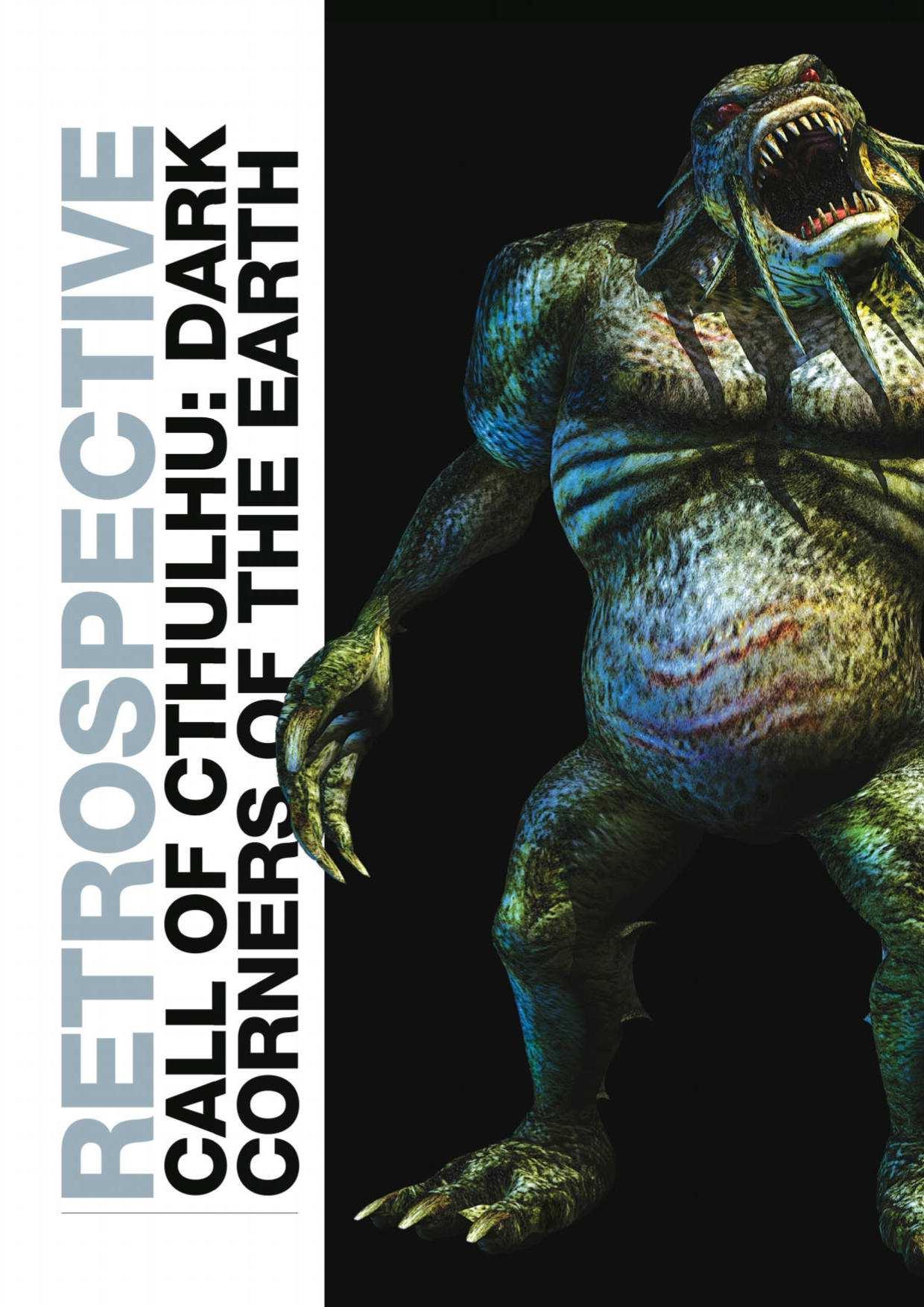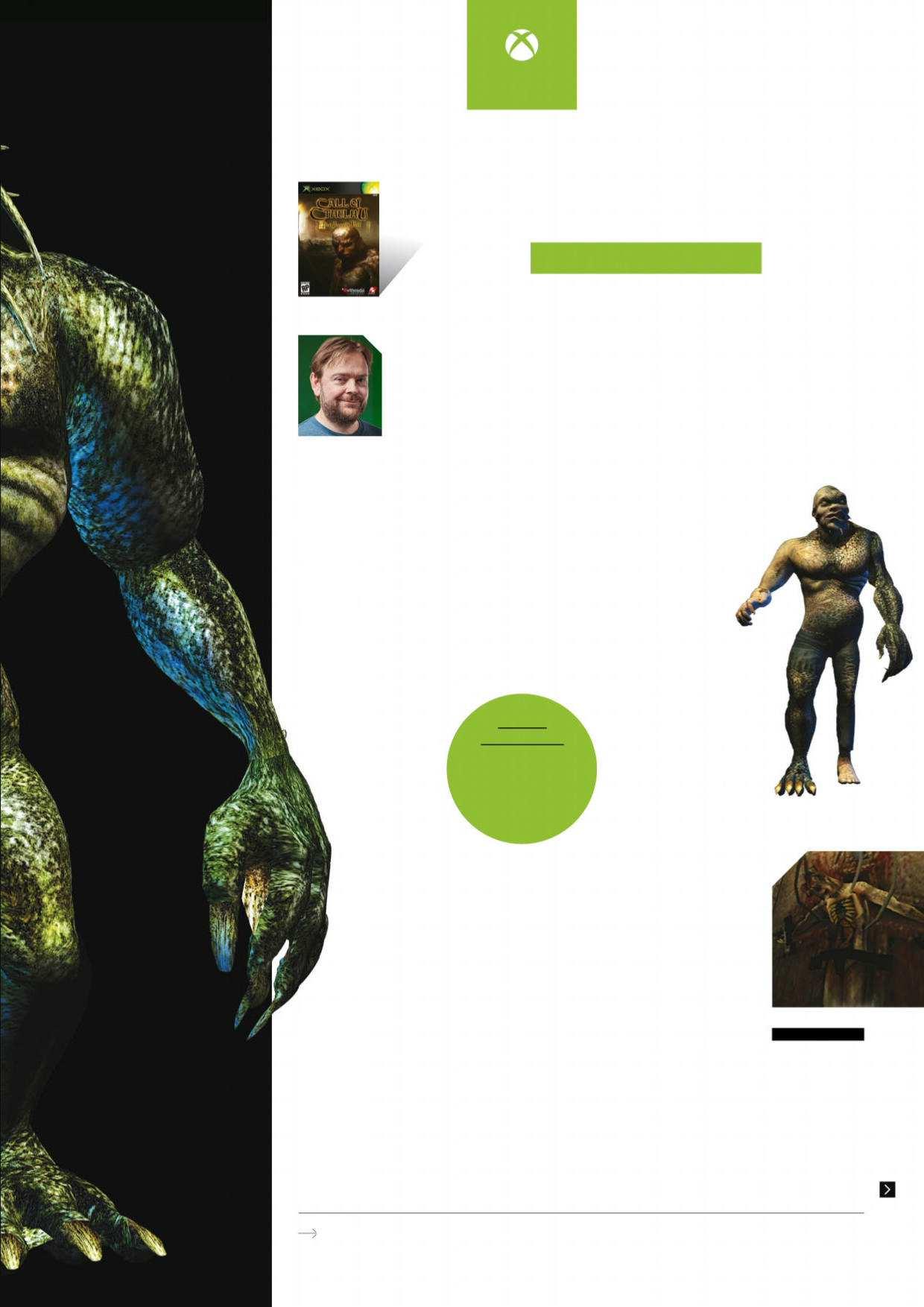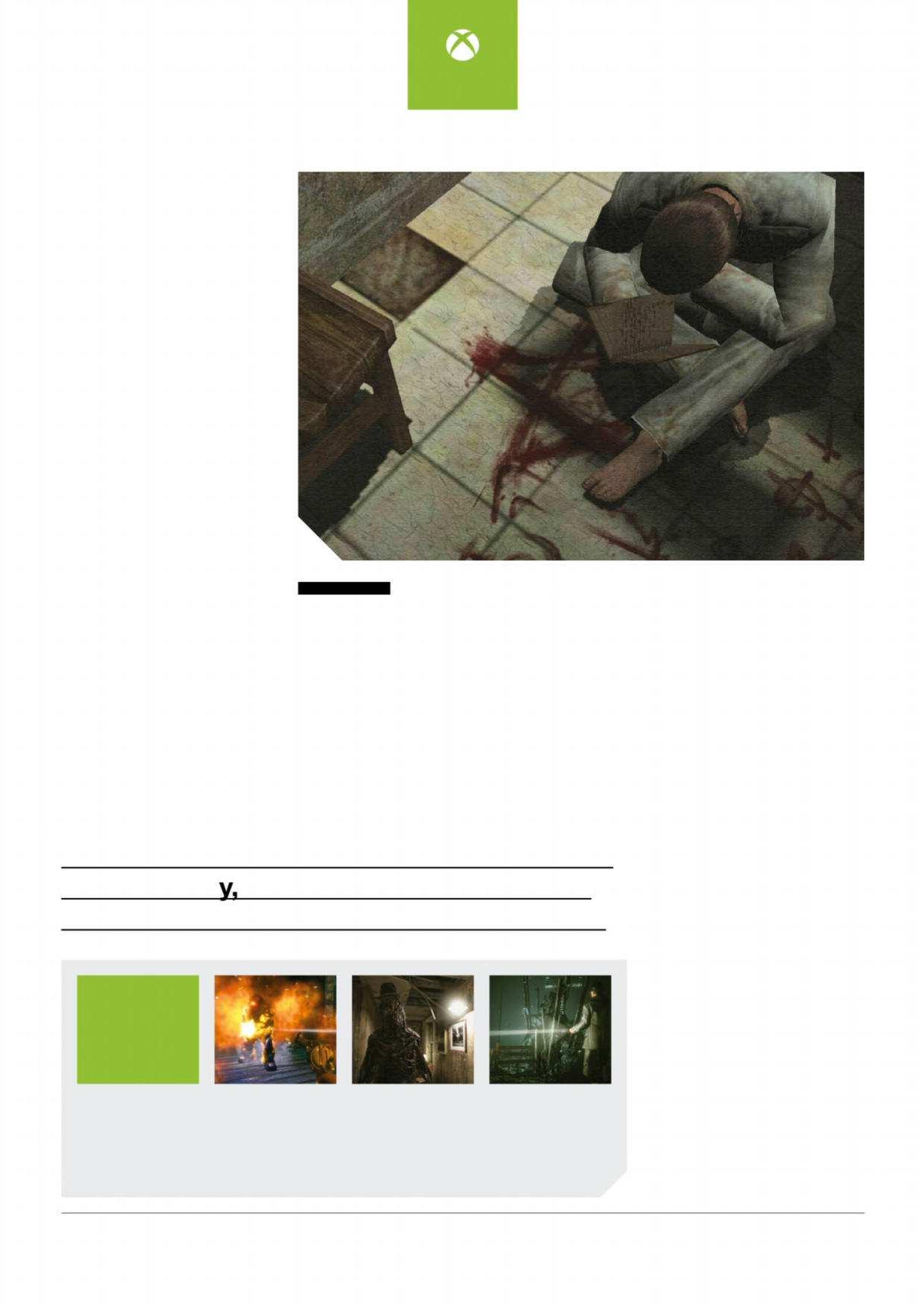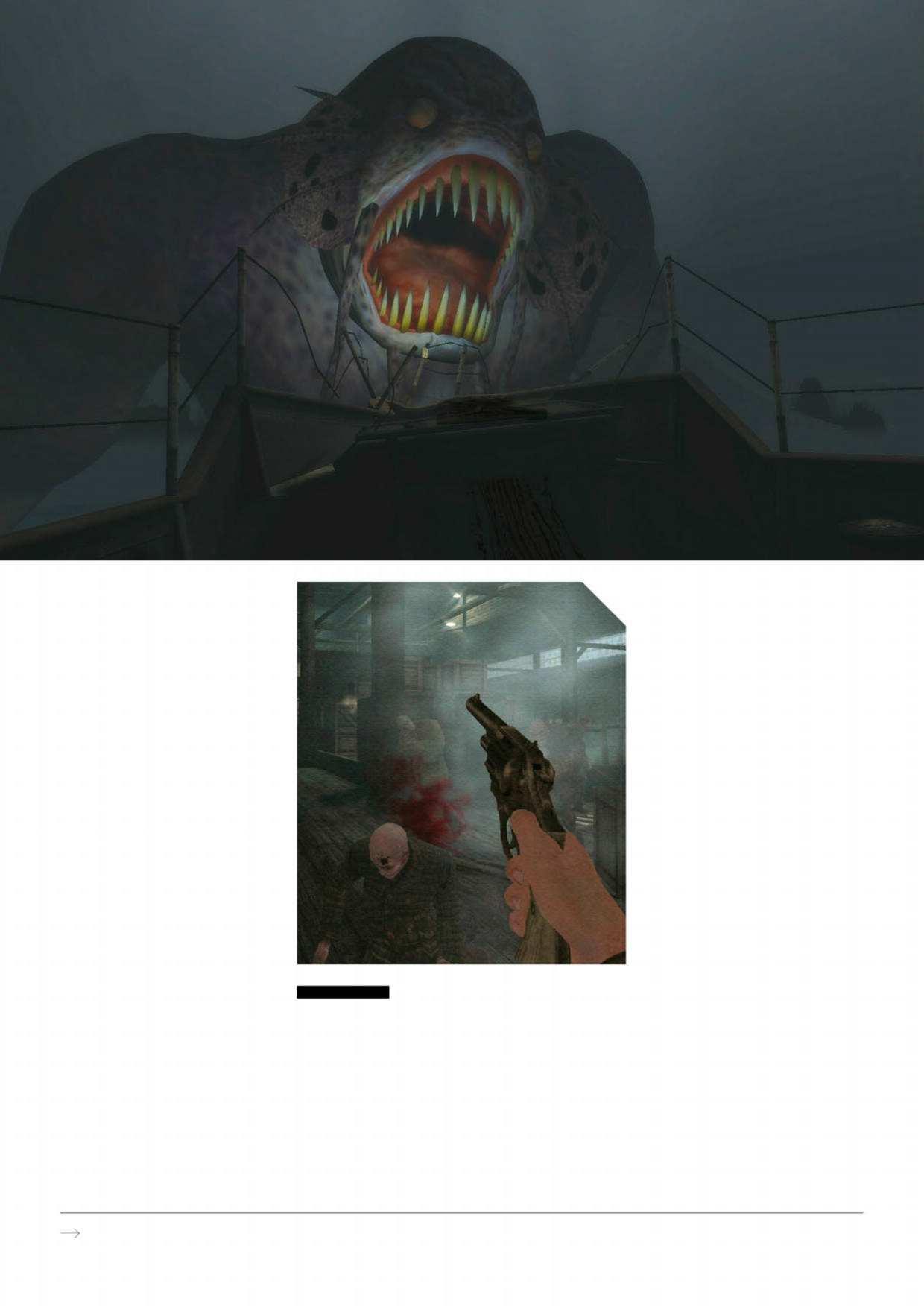
10 minute read
RETROSPECTIVE DARK CORNERS OF THE EARTH
With a new game based on Call Of Cthulhu out next month, OXM fires up the original Xbox and shines a light into the Dark Corners Of The Earth CHRIS BURKE
PUBLISHER BETHESDA / DEVELOPER HEADFIRST PRODUCTIONS / FORMAT XBOX
Almost a century on, the stories of American pulp fiction writer Howard Phillips Lovecraft remain among the most d brilliant horror fiction ed to paper. The mythos f terrifying elder races s, existing millennia s and unfathomable of men, enjoys cult d he is an established ror who has influenced ephen King, despite his poverty, unappreciated gift was in relating his aginatively terrifying he more banal fears mad prophets who too much in the e insane; the d schmo for atching urns out hing way rats; arances urders in communities for hapless tigators, have nations so far beyond n that, as they peel the layers of these eries, their own sanity is d by their discoveries. ecraft’s stories became of ’60s counterculture fantastical themes in came popular, alongside
Huxley and Tolkien. His ntinued to grow in the ades, but few games, er movies, have even t to tackle the writer’s ps the unimaginable d in Lovecraft’s oo unimaginable for even the videogames since the ’80s, rilliant tabletop RPG iled the experience of mysteries in the 1920s world of Lovecraft’s stories, complete with a neat mechanic whereby characters’ sanity is as much a factor as hit points and other more typical RPG stats, and is eroded by horrifying encounters and situations. Cyanide Studios’ new Xbox One Call Of Cthulhu game is based on Chaosium’s RPG, and we’re hoping it can do justice to the pen and paper game and Lovecraft’s mythos as a whole. But back in 2005, one game that slippe under the radar of most gamers wh it was released on the original Xbo delivered on Cthulhu in spades. HP source Horror FPS Call Of Cthulhu: Dark Corners Of The Earth takes its main inspiration from Lovecraft’s 1931 work The Shadow Over Innsmouth, with its suffocating setting of a sinister fictional New England fish port hidden by inhospitable salt marshes from the re
WHO YA of the United States.
GONNA CALL? The game starts
In HP’s 1928 The Call with the protagonistOf Cthulhu, octopusfaced evil cosmic entity attempted suicide in Cthulhu was asleep in a an insane asylum, so sunken city until some you know it’s not going fool woke him up. to end well. You then play through flashback, as doomed detective Jack Walters, as he tries to negotiate the siege of a house where a cult are trading shots with police. Inside, you discover strange devices in the basement, and a disembowelled man strapped to a machine with all his organs still functioning in separate tanks. You flick a switch (of course you do) and his head explodes. Oops. Then you do a bad thing. Again. Putting a strange crystal power source into another machine (of course you would), all hell literally breaks loose. As you slip into blurry unconsciousness, the last thing you see is a genuinely terrifying alien monster, never quite fully in focus, and all the more effective for it. One of the first things you notice, pretty much unheard of at the time, is the total lack of any HUD. There is nothing at all on your screen, not even an aiming reticule. You have

influential and ever committe he created, of from the stars t before human ed to the minds o hen popularity, an x, master of horr writers like St having died in in his time.
Lovecraft’s n bizarre and im monsters to th of men. The m had glimpsed hing stars and gon e sleep-deprive est whom the scra in the walls tu to be someth ’s worse than disappea o and mu ng small c that, f invest expla reaso away myste eroded Love a part o as more fiction bec the likes of cult status co following deca and even fewe dared attempt canon. Perhap horrors birthed mind proved t Hollywood, or industry. But s Chaosium’s br has utterly na investigating
ABOVE You make a lot of truly gruesome discoveries in the game, that test your character’s sanity.
an inventory that is accessible by pressing the black button on the Xbox controller, but otherwise you have to centre your view on an object before interacting. Your physical and mental condition is indicated by your heartbeat and breathing. As you discover dismembered corpses (or worse), your heartbeat – and controller vibrations – get faster and more intense; look at something nasty for too long and your vision starts to blur as your sanity is tested.
The lack of a HUD really helps your immersion – blood splatters onto the screen if you get shot or hit, the colour drains from the screen completely if things get too bad. Injuries are realistically represented; hurt your leg and you limp; get shot in the arm and you have difficulty aiming. When you finally get hold of a gun, you have to aim down its iron sights. But this is not meant to be a shooter; you spend less time facing down foes than running away from them. That doesn’t make the FPS’ing any less satisfying against gun-toting locals and cultists when it does happen. A bit fishy
Six years after this first incident, it’s now 1922, and Jack’s out of Arkham Asylum. No, not that one; Lovecraft’s fictional Massachusetts town of Arkham had its mental institution 50 years before Gotham did. He is returning to a normal-ish existence, and takes a job investigating the disappearance of a young grocery store manager in Innsmouth.
As you begin to investigate the
ABOVE You don’t have to be crazy to work here, but it helps… The game’s main protagonist is not in the best of mental health. atmospherically gloomy, sea-foggy town, you find hostility from the bizarre-looking locals and fear from the more normal-looking inhabitants. There’s detecting required here, and the game doesn’t hold your hand. A key on a desk does not glow; you could miss it if you’re not looking properly. Throughout your investigations, mad Jack gets ‘glimpses’ from the perspective of something watching him, deranged second-sight that adds to the menace. As you get deeper into the mystery, you meet a young girl called Ramona, whose mommy ‘bites’ and is kept in the attic. She’s busy drawing pictures of ‘mommy and daddy’, and even in its primitive resolution, what she’s drawing is a little unnerving. Then you let mom out of the attic (of course you do). Coming-to and heading back downstairs, you find the poor mutilated Ramona in the arms of her distraught father, who is then hauled off for her murder. It’s all going a bit tits up. Well done you.
But then comes the game’s piece de resistance, one of the best ever moments in a survival horror game, as well as being a near-exact realisation of The Shadow Over Innsmouth’s most memorable passage.
Checking into the local run-down hotel and hitting the hay, you’re awoken by a premonition of men coming to get you. These fugly, hunched, gravel-voiced, inbreds (it’s the ‘Innsmouth look’) are outside your room, all shotguns and murderous intent. Without any means to fight back – no gun yet – you run for your life through adjoining rooms, bolting doors behind you, and moving wardrobes in front of them to slow up your pursuers. Timing is absolutely crucial, a second’s slip and they’re on you. Then it’s out the window, across fire-escapes to the opposite building, fleeing down dingy corridors, ducking as gunshots are fired from across the way, glass crashing all around you. The visuals can easily wibble into a trippy haze if you so much as look back, as Jack’s mind begins to slip… in one room, there’s a scaly fish woman
HORROR HIGHS
Survival horror games are plentiful on Xbox, but here are three that really deliver on Lovecraft-style deep storytelling, investigation and sanity-testing thrills.
WATER WAY TO GO BIOSHOCK
The sea plays a big part in HP’s stories and Cthulhu himself would feel right at home among Rapture’s twisted denizens. HOME ON THE STRANGE RESIDENT EVIL 7
A fresh perspective on RE, literally. As you investigate its world in first-person, things feel all the more immersive and terrifying. WAKE UP, TIME TO CRY AL AN WAKE
Themes of insanity and unknown horrors in the dark… more King than Cthulhu, but Stephen was influenced by Lovecraft.

sleeping on a bed, who wakes up and starts screaming pathetically. You don’t have time to properly examine this creature as you stumble through the room – you just clock it’s there.
As the plot deepens and the onion layers are stripped away, so too the menace becomes less subtle and the monsters more frequent, and there are even some key mythos A-listers to deal with. Jack himself, it’s finally revealed in a proper Lovecraftian twist, is connected somehow to a race from beyond the stars, and he gets glimpses of their otherdimensional cities. It’s ambitious stuff for a noughties videogame. In fact there is so much accurate Lovecraft detail throughout that it’s a really accomplished fan-work, and it holds up as a great game even now. We’d love to get a 4K remaster.
The game is fairly scripted and mostly linear; but there wasn’t really the processing power, or even the need, for open-world freedom. The building horror and intriguing narrative drive are well suited to a linear path. In any case, in the best Lovecraftian tradition, there is a pre-ordained inevitability to the direction in which the doomed hero is headed.

’Crafty devs
The team behind Dark Corners were Headfirst Productions, the father and son team of Mike and Simon Woodroffe. Mike had established Adventure Soft in Sutton Coldfield, in the UK’s West Midlands, in the 1980s,
TOP That would be Dagon, one of the top boys in Lovecraft’s mythos.
ABOVE A warm welcome is assured in Innsmouth, unless you’re not from Innsmouth. a software house that created the Simon The Sorcerer games on the Amiga and DOS for IBM’s PCs. Dark Corners had been in development since 1999, when Headfirst made the smart move of seeking ideas from an online Lovecraft fan group, and a ‘First Person Horror Adventure Shooter’ began to take shape. Sadly over time some of the more ambitious and far-reaching ideas were pared back, presumably due to the technological limitations of the time. Headfirst had envisaged the game as having a non-linear, RPG feel – more like the game by Chaosium, with whom they’d secured the rights to use the Cthulhu name – with more characters, and a co-op element for up to four players.
Development limped on and a PS2 version was abandoned completely after Headfirst eventually signed a publishing deal with Bethesda. But despite its development hell, the game that was ultimately released on Xbox in 2005 was a benchmark of survival horror whose influence can be felt in Bioshock and other non-shooter FPS’s since. Perhaps it was the rather drab box-art, or the fact that you really had to know about Lovecraft and Cthulhu to understand what the game was offering, but although critically well-received the title sold disappointingly, and Headfirst went bankrupt before a planned sequel, Destiny’s End, could be completed.
All of which means we’ve waited 13 long years for a new Lovecraft game on Xbox, and with the forthcoming Call Of Cthulhu and Sinking City, it looks like two are coming along at once. From what we’ve seen of the most imminent of these, Call Of Cthulhu (see page 34), it looks like more than just a spiritual successor to Dark Corners, with its first-person perspective, coastal New England location, your character’s struggle to maintain his sanity and deep investigation elements. If that game manages to capture even a little of Headfirst’s ambition, atmosphere and Lovecraft-ness, we can’t wait to go crazy playing it.










